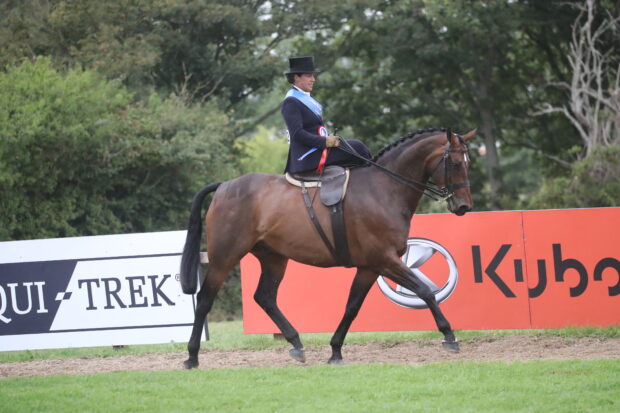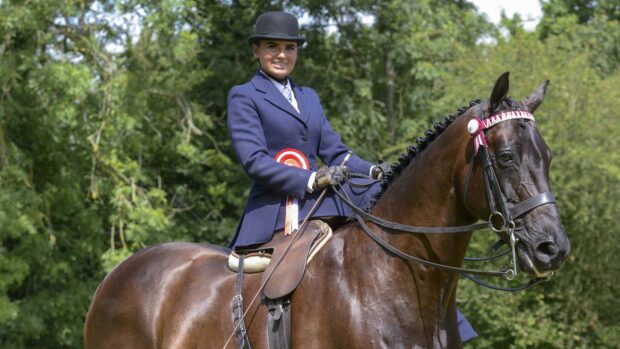If you love a good period drama such as Downton Abbey, you may have admired the skill and elegance of the side saddle riders with their sweeping habits and beautiful turnouts. Riding side saddle, though, isn’t confined to the history books — it’s a popular discipline today and very relevant to the modern rider.
The Side Saddle Association help to encourage and promote the discipline to today’s riders in the UK. Janet Senior has been a member of the Association since 1987, holding various posts on the committee before becoming chairman in 2014.
“I first became a devotee of the discipline in 1969 aged 12, when I watched the May Queen and her attendants riding side saddle on Shire horses in the Gawthorpe Maypole Parade walk by,” she says. “The colour and spectacle made quite an impression on me, and from that moment on I was hooked. I would ride my ex-pit pony (one of the last ones brought up from the coal mines, and on loan from the Blue Cross at a cost of £5!) sitting sideways bareback and pretending I was the May Queen! And yes, I did fall off a lot, but those balance skills stood me in good stead in later life. I eventually taught myself to ride side saddle and trained my horses to it too before joining the association.

Janet Senior
“Now a national and international instructor, trainer, coach, judge, examiner and competitor, I am passionate about the development, education and welfare of the side saddle horse and rider, including riders with physical and learning disabilities.”
Compared to riding astride, as a side saddle rider you sit further back and on more top of the horse with both your legs positioned on one side. You also carry a cane to use as a guide and support and to give aids to the horse, and have a longer length of rein. The ultimate aim of a good side saddle rider is to be straight, balanced and in harmony with your horse, exactly the same as if you were riding astride.
Side saddle instructor, coach and judge Lisa Lane was introduced to the discipline about 23 years ago, when she looked after a horse who came with a side saddle and was urged by the owner to have a go.
“When the owner came back, I had to admit I hadn’t been able to work out how to put the saddle on properly — at the time I was eventing and showjumping, and had never seen a side saddle!” laughs Lisa. “I had a lesson, though, and was soon hooked. The transition from astride to side saddle depends entirely on the person making it. Some people find it very easy and will be cantering in the first lesson, others absolutely hate it and want to get straight back off, even if they ride well astride. I always say it’s like Marmite, you will either love it or hate it, there doesn’t seem to be much in between.

Lisa Lane. Credit: Anne Chambers
“Most horses will take to side saddle. It is important that they are sound and without health issues, and have a good basic astride education and good temperament — naughty horses who like to rear or spin and spook are not the most suitable candidates for side saddle. Side saddle is becoming a very popular job for horses who are looking for an easier second competitive life as they get older. For example ex-racehorses and eventers.”
It may look completely impossible, but both Janet and Lisa agree that jumping side saddle can be done.
“Jumping side saddle is better done in a straight line,” says Janet. “Generally, the side saddle has two pommels on the near side and exerts a gravitational pull to the left, so the rider needs to counter balance against this to avoid becoming unseated.”
“The current height record for jumping side saddle is 6’8”, held by Irish rider Susan Oakes,” adds Lisa. “Side saddle is becoming popular again among ladies who hunt, and we have a variety of jumping classes at the national side saddle show.”
“If you’re even remotely tempted to have a go, then I’d thoroughly recommend it,” says Janet. “Side saddle is a unique art and way of riding, giving a feeling of grace and elegance while linking the past to the present. Every side saddle rider I have ever worked with or met is drawn to that time and place when side saddle riding was in its prime. There is no other discipline like it, and it gives you a great sense of achievement and pride.”
For more information about taster sessions, to find an instructor in your area or for clinics, courses, training days, demonstrations and competitions, visit the website of the Side Saddle Association.
For all the latest equestrian news and reports, don’t miss Horse & Hound magazine, out every Thursday.
You might also be interested in:

Fancy trying your hand at horse agility? Here’s what you need to know first…

Try something new – polo

Subscribe to Horse & Hound magazine today – and enjoy unlimited website access all year round




